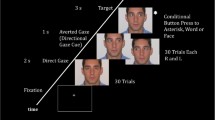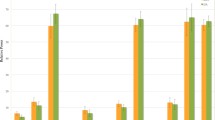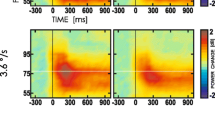Abstract
The interactions between gaze processing and neural activities mediate cognition. The present paper aims to identify the involvement of visual and neural dynamics in shaping the cognitive behavior in Autism Spectrum Disorder (ASD). Electroencephalogram (EEG) and Eye-tracker signals of ASD and Typically Developing (TD) are recorded while performing two difficulty levels of a maze-based experimental task. During task, the performance metrics, complex neural measures extracted from EEG data using Visibility Graph (VG) algorithm and visual measures extracted from eye-tracker data are analyzed and compared. For both task levels, the cognition processing is examined via performance metrics (reaction-time and poor accuracy), gaze measures (saccade, fixation duration and blinkrate) and VG-based metrics (average weighted degree, clustering coefficient, path length, global efficiency, mutual information). An engagement in cognitive processing in ASD is revealed statistically by high reaction time, poor accuracy, increased fixation duration, raised saccadic amplitude, higher blink rate, reduced average weighted degree, global efficiency, mutual information as well as higher eigenvector centrality and path length. Over the course of repetitive trials, the cognitive improvement is although poor in ASD compared to TDs, the reconfigurations of visual and neural network dynamics revealed activation of Cognitive Learning (CL) in ASD. Furthermore, the correlation of gaze-EEG measures reveal that independent brain region functioning is not impaired but declined mutual interaction of brain regions causes cognitive deficit in ASD. And correlation of EEG-gaze measures with clinical severity measured by Autism Diagnostic Observation Schedule(ADOS) suggest that visual-neural activities reveals social behavior/cognition in ASD. Thus, visual and neural dynamics together support the revelation of the cognitive behavior in ASD.








Similar content being viewed by others
References
Kakkar D (2019) Diagnostic assessment techniques and non-invasive biomarkers for autism spectrum disorder. IJEHM 10:79–95. https://doi.org/10.4018/ijehmc.2019070105
Brunsdon VE, Colvert E, Ames C, Garnett T, Gillan N, Hallett V, Happé F (2015) Exploring the cognitive features in children with autism spectrum disorder, their co-twins, and typically developing children within a population-based sample. J Child Psychol Psychiatry 56:893–902. https://doi.org/10.1111/jcpp.12362
Wadhera T, Kakkar D (2020) Multiplex temporal measures reflecting neural underpinnings of brain functional connectivity under cognitive load in autism spectrum disorder. Neurol Res 42:327–339. https://doi.org/10.1080/01616412.2020.1726586
Haebig E, Saffran JR, Ellis Weismer S (2017) Statistical word learning in children with autism spectrum disorder and specific language impairment. J Child Psychol Psychiatry 58:1251–63. https://doi.org/10.1111/jcpp.12734
Ruffman T, Taumoepeau M, Perkins C (2012) Statistical learning as a basis for social understanding in children. Br. J. Dev. Psychol 30:87–104. https://doi.org/10.1111/j.2044-835X.2011.02045.x
Tanu T, Kakkar D (2018) Strengthening risk prediction using statistical learning in children with autism spectrum disorder. Adv Autism 4:141–152. https://doi.org/10.1108/AIA-06-2018-0022/full/html
Wadhera T, Kakkar D (2020) Modeling risk perception using independent and social learning: application to individuals with autism spectrum disorder. J Math Sociol 44:1–23. https://doi.org/10.1080/0022250X.2020.1774877
Jeste SS, Kirkham N, Senturk D, Hasenstab K, Sugar C, Kupelian C, Paparella T (2015) Electrophysiological evidence of heterogeneity in visual statistical learning in young children with ASD. Dev Sci 18:90–105. https://doi.org/10.1111/desc.12188
Raviv L, Arnon I (2018) The developmental trajectory of children’s auditory and visual statistical learning abilities: modality-based differences in the effect of age. Dev Sci 21:1–13. https://doi.org/10.1111/desc.12593
Obeid R, Brooks PJ, Powers KL, Gillespie-Lynch K, Lum JA (2016) Statistical learning in specific language impairment and autism spectrum disorder: a meta-analysis. Front Psychol 7:1–18. https://doi.org/10.3389/fpsyg.2016.01245/full
Siegelman N, Bogaerts L, Frost R (2017) Measuring individual differences in statistical learning:current pitfalls and possible solutions. Behav Res 49:418–32. https://doi.org/10.3758/2Fs13428-016-0719-z
Khedher AB, Jraidi I, & Frasson C (2019, May) Predicting learners’ performance using EEG and eye tracking features. In: The Thirty-Second International Flairs Conference
Luna B, Velanova K, Geier CF (2008) Development of eye-movement control. Brain Cogn 68:293–308. https://doi.org/10.1016/j.bandc.2008.08.019
Foti F, De Crescenzo F, Vivanti G, Menghini D, Vicari S (2015) Implicit learning in individuals with autism spectrum disorders: a meta-analysis. Psychol Med 45:897–910. https://doi.org/10.1017/S0033291714001950
Marin A, Hutman T, Ponting C, McDonald NM, Carver L, Baker E, Jeste SS (2020) Electrophysiological signatures of visual statistical learning in 3-month-old infants at familial and low risk for autism spectrum disorder. Dev Psychobiol. https://doi.org/10.1002/dev.21971
Bassett DS, Yang M, Wymbs NF, Grafton ST (2015) Learning-induced autonomy of sensorimotor systems. Nat Neurosci 18:744–751. https://doi.org/10.1038/nn.3993
American Psychiatric Association Division of Research (2013) Highlights of changes from DSM-IV to DSM-5: somatic symptom and related disorders. Focus 11:525–527. https://doi.org/10.1176/appi.focus.11.4.525
Malin AJ (1969) Manual for malin’s intelligence scale for indian children (MISIC). Indian Psychological Corporation, Lucknow
Nyström M, Holmqvist K (2010) An adaptive algorithm for fixation, saccade, and glissade detection in eyetracking data. Behav Res Meth 42:188–204. https://doi.org/10.3758/BRM.42.1.188
Lacasa L, Luque B, Ballesteros F, Luque J, Nuno JC (2008) From time series to complex networks: the visibility graph. Proc Natl Acad Sci 105(13):4972–4975. https://doi.org/10.1073/pnas.0709247105
Soulieres I, Zeffiro TA, Girard ML, Mottron L (2011) Enhanced mental image mapping in autism. Neuropsychologia 49:848–857. https://doi.org/10.1016/j.neuropsychologia.2011.01.027
Gharib A, Mier D, Adolphs R, Shimojo S (2015) Eyetracking of social preference choices reveals normal but faster processing in autism. Neuropsychologia 72:70–79. https://doi.org/10.1016/j.neuropsychologia.2015.04.027
Joseph RM, Keehn B, Connolly C, Wolfe JM, Horowitz TS (2009) Why is visual search superior in autism spectrum disorder? Dev Sci 12:1083–1096. https://doi.org/10.1111/j.1467-7687.2009.00855.x
Borghini G, Astolfi L, Vecchiato G, Mattia D, Babiloni F (2014) Measuring neurophysiological signals in aircraft pilots and car drivers for the assessment of mental workload, fatigue and drowsiness. Neurosci Biobehav Rev 44:58–75. https://doi.org/10.1016/j.neubiorev.2012.10.003
Schmitt LM, Cook EH, Sweeney JA, Mosconi MW (2014) Saccadic eye movement abnormalities in autism spectrum disorder indicate dysfunctions in cerebellum and brainstem. Mol Autism 5:47. https://doi.org/10.1186/2040-2392-5-47
Lacasa L, Luque B, Ballesteros F, Luque J, Nuno JC (2008) From time series to complex networks: the visibility graph. Proc Natl Acad Sci 105:4972–4975. https://doi.org/10.1073/pnas.0709247105
delEtoile J, Adeli H (2017) Graph theory and brain connectivity in Alzheimer’s disease. Neuroscientist 23:616–626
Reber PJ (2013) The neural basis of implicit learning and memory: a review of neuropsychological and neuroimagingresearch. Neuropsychologia 51:2026–2042. https://doi.org/10.1016/j.neuropsychologia.2013.06.019
Acknowledgements
We would like to thank the Local NGOs for allowing us to recruit the ASD children for the experimental study and also the hospital team for providing the EEG signals under their supervision.
Funding
The present work is not supported by any Funding Agency in public or non-profit sectors.
Author information
Authors and Affiliations
Corresponding author
Ethics declarations
Conflict of interest
The authors declare no conflicts of interest.
Ethical approval
The present work is ethically approved by the Institute Ethical Committee (Dr B R Ambedkar National Institute of Technology, Jalandhar, with Approval ID: NITJ/EC 568712092018) and acted according to APA standards.
Informed consent
Informed written consent was obtained from all the participants and their parents/guardians as well.
Additional information
Publisher's Note
Springer Nature remains neutral with regard to jurisdictional claims in published maps and institutional affiliations.
Rights and permissions
About this article
Cite this article
Wadhera, T., Kakkar, D. Analysis of simultaneous visual and complex neural dynamics during cognitive learning to diagnose ASD. Phys Eng Sci Med 44, 1081–1094 (2021). https://doi.org/10.1007/s13246-021-01045-8
Received:
Accepted:
Published:
Issue Date:
DOI: https://doi.org/10.1007/s13246-021-01045-8




